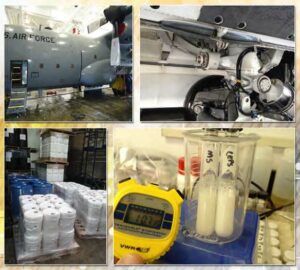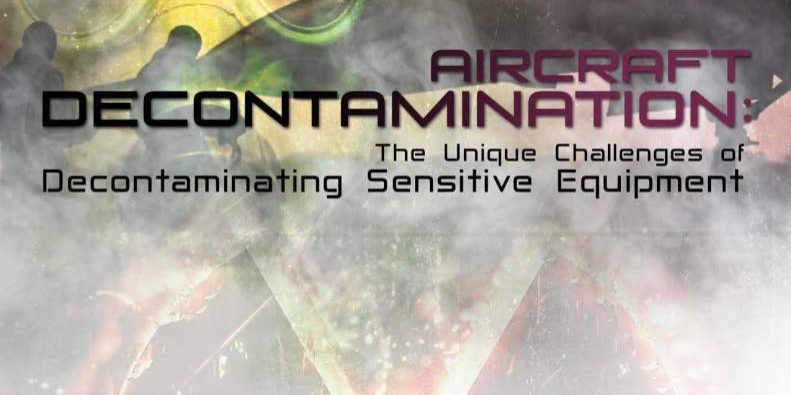Aircraft are extremely expensive and sensitive assets, critical for both defense and transportation. Chemical products used on an aircraft must meet strict materials compatibility requirements to ensure they do not degrade, shorten the life expectancy or cause failure of any aircraft component.
Aircraft contaminated with toxic chemicals cannot be decontaminated using traditional decon solutions, which include oxidants such as bleach or hydrogen peroxide. Using these reactive materials would corrode parts; causing the need to identify and replace damaged components to prevent catastrophic failure. Decontaminants that remove the toxic chemicals without harming the aircraft are essential.
In the fall of 2009, the Department of Defense Joint Science and Technology Office and Joint Program Executive Office for Chemical and Biological Defense began developing a surfactant technology for surface chemical and biological agent removal. The goal of this effort was to develop a detergent formulation specifically tailored to remove chemical and biological agents from contaminated surfaces, and had excellent compatibility with all components of an aircraft.

Figure 1: C-130 wash (upper left), C-17 landing gear wash (upper right), SSDX-12 manufacturing (lower left), stimulant agents remain emulsified after one hour (lower right). (Released)
To ensure the product would be successful and widely accepted it would be a dual use item, both for decontamination and as an aerospace equipment-cleaning compound qualified under military and commercial standards.
The advanced detergent product borne from this effort was the first dual use aircraft cleaning and decontaminant technology available, creating a new capability unavailable until now. It was specifically designed to emulsify and lift chemical warfare agents from military painted surfaces.
Its key feature is the stable emulsion that is formed when the water-detergent solution is sprayed over the plane; the emulsion keeps the agents in solution so that they do not redeposit even on a large aircraft surface. The product does not contain a reactive chemistry, as this would not be compatible with the aircraft. It lifts agents from the surface and allows them to be washed off; the runoff can then be neutralized using traditional methods.
To ensure the oily, water-insoluble agents can be removed from the surface of aircraft, the surfactant concentration is much higher than traditional cleaners. This provides the added benefit that when the product is used as a cleaner, it can be diluted to a greater extent than traditional cleaners, like high efficiency products used in today’s washing machines. Customers using this product for cleaning realize cost savings because it can be diluted further than traditional cleaners; requires less shipping and storage; reduces ordering frequency; and quicker cleaning reduces labor and cleaning pad costs.
In addition to decontaminating aircraft, the U.S. Army Research Office demonstrated and qualified the product in its auto-decontamination system, a portable demonstration device for initial vehicle wash and gross contaminant removal and decontamination. This unit is designed to automate the difficult and dangerous task of an operator washing a vehicle while dealing with the potential splash back of toxic materials while wearing protective Mission-Oriented Protective Posture gear, which can be physically demanding and cause excessive heat stress.
The product is qualified to U.S. Air Force standard MIL-PRF-87937D for a type IV heavy duty water dilutable aircraft cleaner. It has impeccable materials compatibility and does not lead to hydrogen embrittlement, or degrade rubber or wiring. The product is pH neutral, biodegradable and has a long shelf life. It has further been shown to contain zero volatile organic compounds and meets many commercial aircraft specifications including AMS 1626C, British Aerospace AIRBUS AIM09-00-002, Boeing D6-17487 and CSD No.1 Type 1.
Hill Air Force Base in Utah qualified the product as the only approved cleaner that can be discharged to the industrial wastewater treatment facility due to compatibility with their heavy metal recovery process. Hill AFB has also used the product as a facilities cleaner, which has shown to help ensure Occupational Safety and Health Administration expanded standard compliance by preventing the migration of toxic heavy metals from aircraft heavy maintenance facilities to worker break rooms and offices.
This patented dual-purpose decontaminant and cleaning product (for both aircraft and facilities) is available under the name SSDX-12™. Additional information can be obtained from TDA Research, Inc. (SSDX-12@tda.com) or their distributor AeroSafe, Inc. (www.aerosafe.com). This effort was funded in part by the U.S. Army Research Office, this information does not necessarily reflect the position or the policy of the government, and no official endorsement should be inferred.
About the author:
Brian France holds a Ph.D. in analytical chemistry and works to bridge fundamental science and customer needs to develop
new commercial products. Dr. France is a Senior Scientist at TDA Research and a Principal Investigator currently
leading several R&D efforts. Dr. France has been involved in chemical defense and decontamination R&D for the past
decade and is an honorably discharged veteran of the U.S. Army. TDA Research, Inc. is a privately owned small business
with significant research and development capabilities. TDA develops technology and manufactures advanced
materials, chemical processes, and aerospace and military hardware. TDA has a history of maturing technologies from
concept to ton size production.


